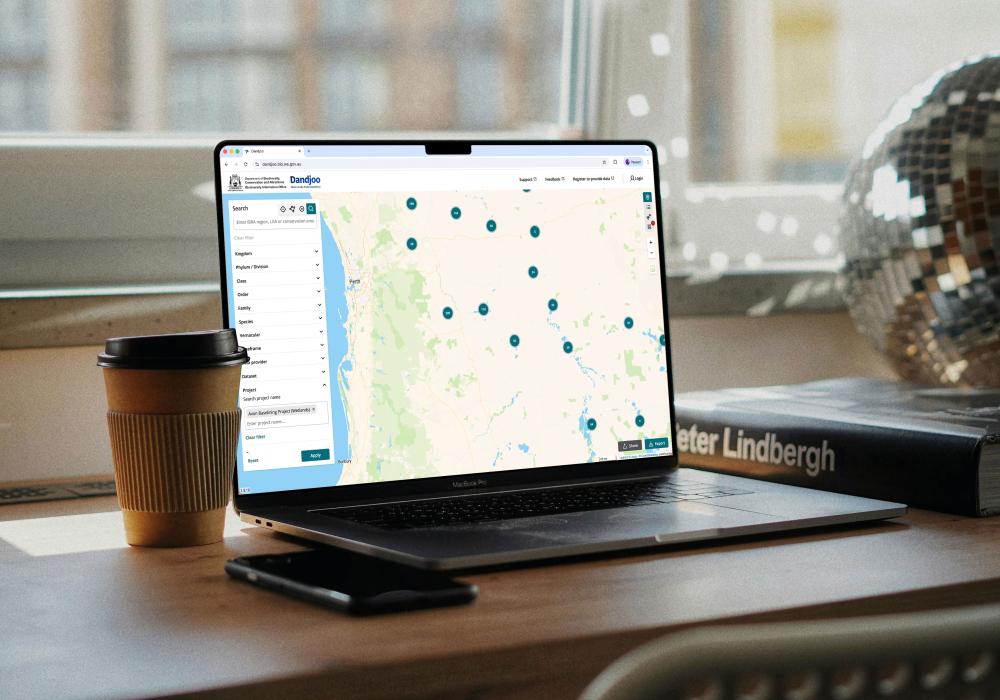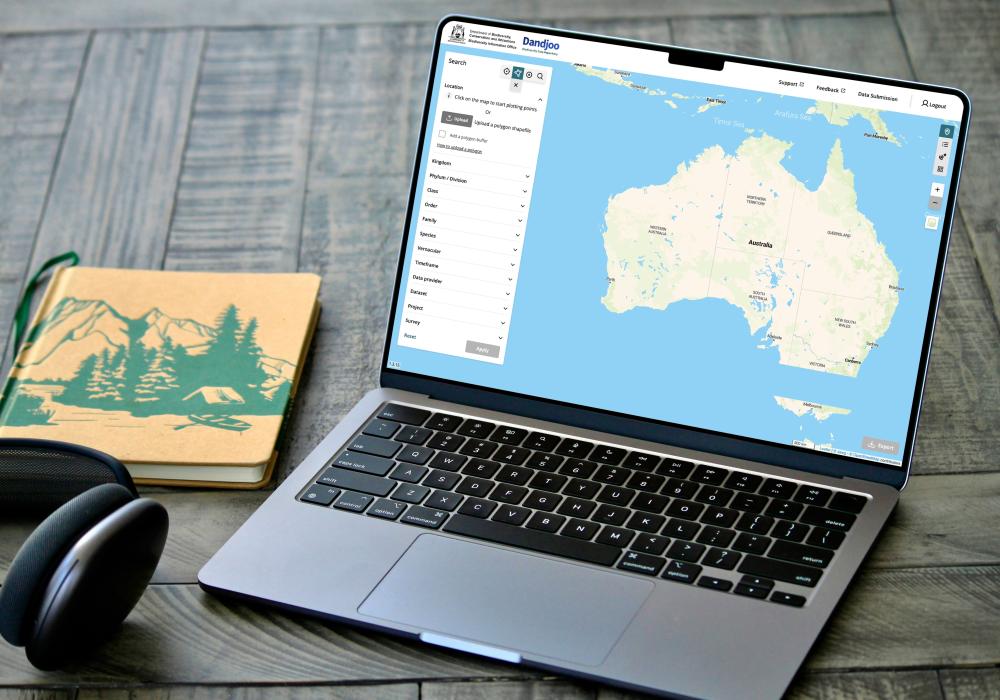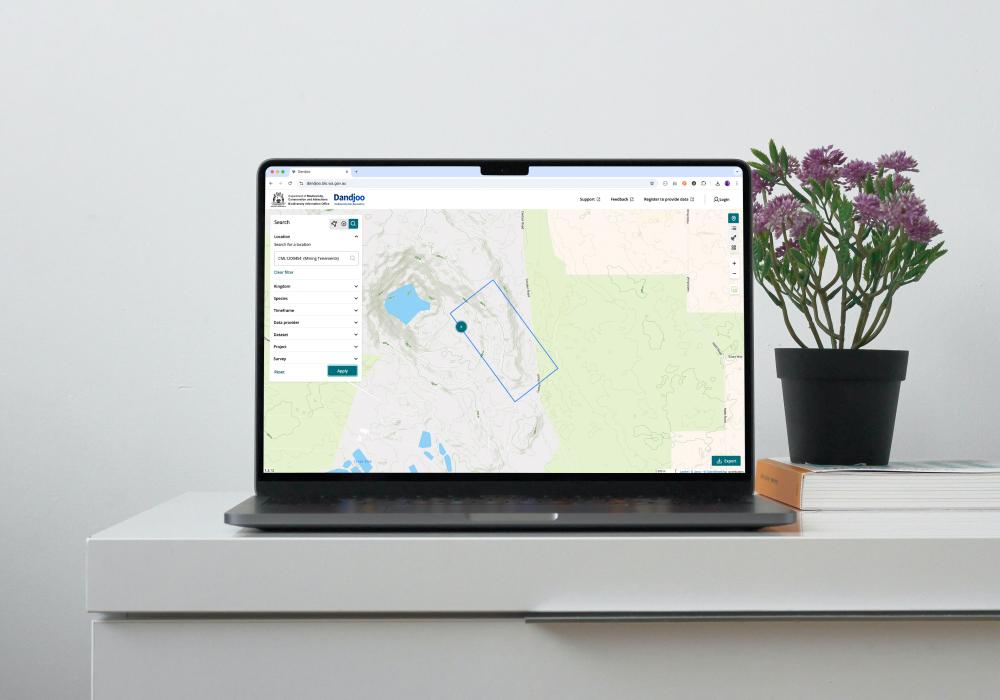Dandjoo biodiversity data platform
High-quality biodiversity data from industry, government, and the research sector.
What is Dandjoo?
Dandjoo is Western Australia’s first whole-of-state biodiversity data platform, providing a way to discover and explore data from government, industry, and research providers.
BIO has developed the platform to support the growth of a high-quality, actively curated data collection. Its data submission tools allow data providers to submit records without the need for extensive reformatting or restructuring, and all records are reviewed by BIO’s curatorial team prior to publication.
Dandjoo also transmits data to the Commonwealth’s Biodiversity Data Repository, allowing researchers and decision-makers to combine Western Australian data with that from other jurisdictions.
The initial release of the platform provides core functionality and more features will continue to be added based on user feedback and engagement to shape future development. Dandjoo is optimised for desktop, although basic mobile functionality has been implemented. The BIO team are keen to hear your thoughts on the refinements and features you’d like to see in the future.
You can learn more about about the meaning of Dandjoo's Noongar-language name on our Naming Dandjoo page.


What’s new for Dandjoo
BIO is working steadily to expand the platform’s capabilities and deliver enhancements and user experience improvements identified by users since launch, some of which are now featured already in production:
- Improved responsiveness, user issues and bug fixes
- Refined UI
- Additional search tool(s)
- Point search (ability to set a search latitude and longitude and set a radius search)
- Search output by taxonomic kingdom (default search includes all kingdoms, or a user can choose one or more as selected)
- Animalia
- Plantae
- Fungi
- Chromista
- Bacteria
- Protozoa
- New exportable data attribute(s)
- dwc:kingdom (‘Kingdom’)
- dwc:phylum (‘Phylum’)
- dwc:class (‘Class’)
- dwc:order (‘Order’)
- dwc:family (‘Family’)
- dwc:establishmentMeans ('Native/introduced/feral')
- dwc:vernacularName ('Vernacular name')
- informalGroup ('Informal group')
- Provision of generalised threatened species data to public users
- Species List report
- Release of the systematic survey data module
- New search and visualisaton options
- New downloads and exports available
What’s next
Additional features in development for release in 2024:
- Inclusion of expanded location data
- National parks
- Conservation parks
- Marine parks
- State forests
- Nature reserves
- External territories
- Platform curation enhancements
- Species List PDF report
- Upload and regular refresh of key datasets available for download from BIO website
Future work includes standardisation and ingestion of existing public Index of Biodiversity Surveys for Assessment (IBSA) datasets as BIO continues to work with DWER to ensure that submissions made as a result of environmental approvals processes and the Environment Online platform are filtered into Dandjoo as an ongoing process.
Collaborative initiatives like this and others will ensure that Dandjoo is regularly refreshed with current data without risk of duplication and will directly reduce impact on industry.
What data can I find in Dandjoo?
BIO actively sources data from a range of industry, research, and government providers – our collection is always growing. You can read about our data contributors and our Frequently Asked Questions to find out more.
At present, much of the data you’ll find in Dandjoo is species observation data – records of a particular species observed or sampled at a specific location at a specific date. With the release of new systematic survey data search and visualisation options, survey data will be accessible and downloadable. BIO is also working on extending visualisation options and searchability for vegetation association data.
In addition to exploring the data via our web platform, you can download a current snapshot of the entire species observation database in our Download Centre, as well as other resources including useful spatial layers.
It’s important to note that observations of threatened and priority species aren’t publicly displayed in Dandjoo. However, the BIO team is working with other Australian jurisdictions on an approach to provide these records with reduced precision, and on processes for sharing specific locations safely with authorised users. The BIO team is also trialling delivery of more precise location data for these species for internal users, but at the current time threatened species information should still be requested via DBCA’s Species and Communities Branch.
Find out more
If you’d like to know more, you can view our Frequently Asked Questions, get in touch with BIO via our contact page.
You can also check out our Dandjoo Conditions of Use and 'How Dandjoo Works' page for data users, and our Data Submission Agreement for data providers.
The Dandjoo biodiversity data platform
Access high-quality Western Australian biodiversity data from from industry, government, and researchers, or share your data on the Dandjoo platform to make it available to a wider audience.

Project Blog
We have added functions to be able to search, view and download (where available) Systematic Survey Data in the Dandjoo platform.
To enhance value of data for users the following additional data attributes have been added to the data exports to better assist in data filtering.
Join the BIO newsletter and get updated first
Sign up for access to the latest developments at the Biodiversity Information Office, upcoming Dandjoo features, and our newest datasets.









